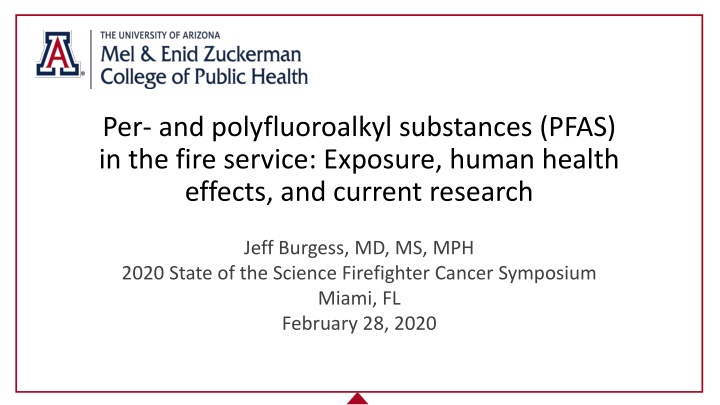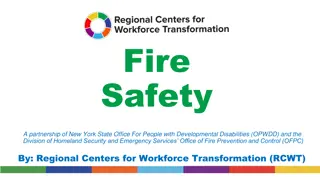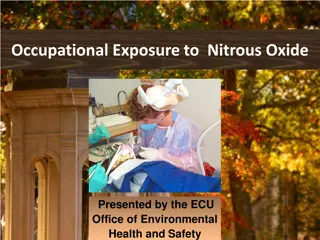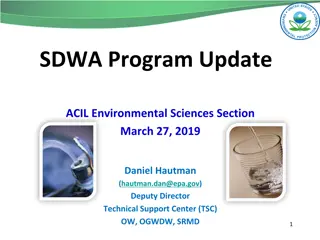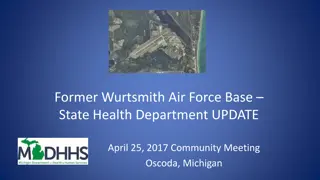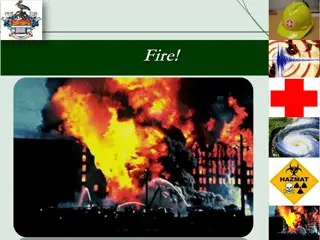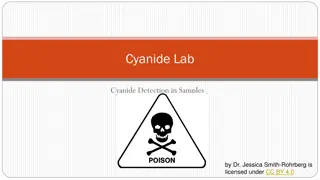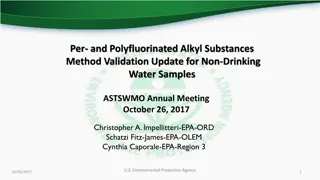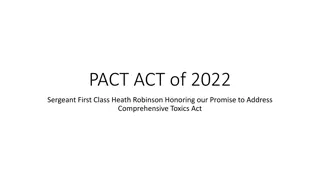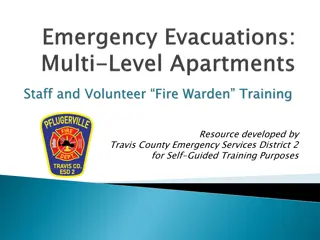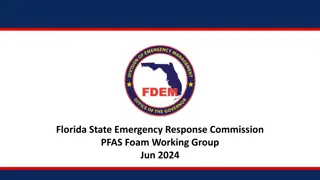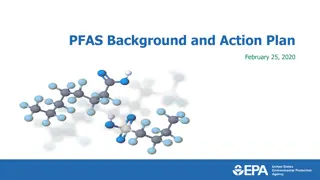PFAS Exposure in Fire Service: Sources, Health Effects, and Research
This presentation discusses per- and polyfluoroalkyl substances (PFAS) in the fire service, including sources, human health effects, and current research. It also highlights the Fire Fighter Cancer Cohort Study (FFCCS) and epigenetic markers' role in gene expression changes without altering DNA sequence.
Download Presentation

Please find below an Image/Link to download the presentation.
The content on the website is provided AS IS for your information and personal use only. It may not be sold, licensed, or shared on other websites without obtaining consent from the author.If you encounter any issues during the download, it is possible that the publisher has removed the file from their server.
You are allowed to download the files provided on this website for personal or commercial use, subject to the condition that they are used lawfully. All files are the property of their respective owners.
The content on the website is provided AS IS for your information and personal use only. It may not be sold, licensed, or shared on other websites without obtaining consent from the author.
E N D
Presentation Transcript
Per- and polyfluoroalkyl substances (PFAS) in the fire service: Exposure, human health effects, and current research Jeff Burgess, MD, MS, MPH 2020 State of the Science Firefighter Cancer Symposium Miami, FL February 28, 2020
Presentation Objectives 1. Describe the point sources and types of per- and polyfluoroalkyl substances (PFAS) found in the firefighter work environment. 2. Discuss the relationship between PFAS exposure and human health effects. 3. Discuss the latest science being conducted on PFAS chemicals and firefighter health and safety.
Presentation Objectives 1. Describe the point sources and types of per- and polyfluoroalkyl substances (PFAS) found in the firefighter work environment. 2. Discuss the relationship between PFAS exposure and human health effects. 3. Discuss the latest science being conducted on PFAS chemicals and firefighter health and safety.
Fire Fighter Cancer Cohort Study (FFCCS) Goal: Establish a thirty year prospective multicenter study of firefighters focused on carcinogenic exposures, effects and cancer prevention 2016 2017 2018 2019 2020 2021 2022 1) FFCCS: Framework 2) FFCCS: Expansion 3) FFCCS: PFAS 4) FFCCS: WUI FEMA AFG EMW-2014-FP-00200, 2015-FP-00213, 2017-FP-00860 & 2018-FP-00086 and NIOSH for FFCCS: WUI
Epigenetic Markers Change in gene expression without changes in DNA sequence Profound roles in carcinogenesis DNA hypermethylation silences tumor suppressor genes microRNA: small molecules that control gene expression Can act as oncogenes or tumor suppressor genes DNA methylation pathway analysis Disease annotation Abdominal cancer p-value # genes Hub genes 5.1e-18 88 STAT3, TP63, TP73, FOXO1, PML, DAXX, RUNX2, INSR, PCNA STAT3, TP63, TP73, FOXO1, DAXX, RUNX2, INSR, PCNA STAT3, TP63, PML, DAXX, RUNX2, INSR INSR, PCNA, STAT3, TP63, TP73 Colon tumor 5.9e-09 44 Skin cancer 2.9e-07 51 Lung tumor 6.6e-07 49 *Comparing male non-smoking incumbents (n=45) to new recruits (n=41), adjusted for age, obesity and ethnicity (Zhou et al. (2019) DNA methylation among firefighters. PLoS ONE 14(3): e0214282) Link et al. Biochem Pharmacol 2010;80:1771-92.
MicroRNA Results Incumbents vs. new recruits* FC 0.55 0.59 0.44 0.56 95% CI 0.43 0.51 0.32 0.48 miRNA Name miR-1260a miR-548h-5p miR-145-5p miR-4516 Role in cancer Tumor suppressor Tumor suppressor Tumor suppressor Tumor suppressor Select cancer associations Brain (glioblastoma) Cervical and lung Prostate Apoptosis of keratinocytes 0.71 0.69 0.61 0.65 Decreased in incumbents 0.60 0.52 0.70 Prostate & colorectal miR-331-3p Tumor suppressor 0.62 0.53 0.72 Lung (Non-small cell) miR-181a-5p Tumor suppressor Increased in 1.59 1.72 1.41 1.40 1.81 2.13 Colon Esophageal & gastric miR-5010-3p miR-374a-5p Tumor suppressor Oncogene incumbents 3.35 2.59 4.33 Colorectal miR-486-3p Oncogene *Fold changes of incumbents (n=52) compared to new recruits (n=45), adjusted for age, obesity and ethnicity, male non- smokers only (Jeong et al., J Occup Environ Med. 2018;60(5):469-474);
Declining Serum Levels for legacy PFAS https://biomonitoring.ca.gov/sites/default/files/downloads/Calafat08222018.pdf
Human Studies: Cancer PFOA is classified as a Group 2B, possible carcinogen, by IARC EPA suggests that PFOA and PFOS are potential carcinogens Occupational Studies Community Studies PFOA: Increase in kidney cancer PFOA: Increase in bladder or testicular cancers and kidney or prostate cancer deaths PFOS: Increase in bladder cancer PFOSA: Increase in breast cancer PFUA, PFOS and PFHxS: Increase in prostate cancer PFHxS: Increase in breast cancer ATDSR, 2018; Hardell et al. (2014). Environment international, 63, 35-39.
PFOS or PFHxS and Prostate Cancer Mean serum PFHxS & PFOS levels (ug/L) Community, case-control study (2007 - 2011) Site PFHxS PFOS Prostate cancer patients (201 cases, 186 controls) Median PFOS serum level = 9 ug/L A Median PFHxS serum level = 0.909 ug/L B Significant higher ORs in cases with a serum level > median and first-degree relative reporting prostate cancer PFOS OR = 2.7 (1.04 - 6.8) PFHxS OR 4.4 (1.7 - 12) C D NHANES Hardell et al. (2014). Environment international, 63, 35-39.
Human Studies: Non-Cancer PFOA and PFOS: Increased risk of hypertension, pregnancy-induced hypertension, thyroid and kidneydiseases, asthma diagnosis, liver damage, stroke, osteoarthritis, and cardiovascular disease. Decreased fertility, antibody response, and birth weight. PFDeA and PFHxS: Increased risk of asthma diagnosis; miscarriage; elevated HDL, LDL,and total cholesterol. Decreased antibody response and fertility. PFUA: Increased risk of pregnancy-inducedhypertension. Decreased antibody response. PFNA: Increased risk of miscarriage, elevated HDL and total cholesterol. ATDSR, 2018
In Vitro Studies PFBA PFHxA PFHpA PFOA PFNA PFDA PFUnDA PFDoDA Fold Change PFBS PFHxS PFOS Fold Change PPARa CIDEA CYP4A11 EHHADH ACOT2 CPT1B BDH2 PCK2 MTRNR2L1 PPARy FABP1 FABP4 PPARa CIDEA CYP4A11 EHHADH ACOT2 CPT1B BDH2 PCK2 MTRNR2L1 PPARy FABP1 FABP4 > 2 > 2 1.5 - 2 1.5 - 2 1 - 1.5 1 - 1.5 CD36 CD36 SLC27A1 MTTP SREBF1 FASN SLC27A1 MTTP SREBF1 FASN 1 1 SCD GPAM LPL ABCA1 CYP7A1 HMGCS1 SAA1 NRF2 SOD1 NQO1 GSTM3 GSTA1 NR1L3 NR1L2 SULT2A1 SLCO1B1 UGT1A1 CYP2B6 SCD GPAM LPL ABCA1 CYP7A1 HMGCS1 SAA1 NRF2 SOD1 NQO1 GSTM3 GSTA1 NR1L3 NR1L2 SULT2A1 SLCO1B1 UGT1A1 CYP2B6 1 - -1.5 1- -1.5 -1.5 - -2 -1.5 - -2 < -2 < -2 25 uM 25 uM 25 uM ROSI 0.25 uM 2.5 uM 0.25 uM Concentration 2.5 uM 0.25 uM 2.5 uM CLO 25 uM 25 uM 25 uM 25 uM 25 uM 25 uM 25 uM 25 uM ROSI 0.25 uM 0.25 uM 0.25 uM 0.25 uM 0.25 uM 0.25 uM 0.25 uM 0.25 uM 2.5 uM 2.5 uM 2.5 uM 2.5 uM 2.5 uM 2.5 uM 2.5 uM 2.5 uM CLO Concentration Provided by Dr. Angela Slitt, University of Rhode Island
